In the report below, I’ve used social listening analysis to understand what’s driving the current female pop phenomenon around Charli XCX, Chappell Roan, and Sabrina Carpenter, and unpacked why any of this matters.
Social Listening
The Rise and Rise of Cosy Culture
This post is a deep dive into cosy culture, and a written version of my talk from the Si Lab Trends summit in April this year.
From adjective to lifestyle: The cosy convergence
I know that cosy is nothing new; it’s been a word we have used to describe a particular feeling for hundreds of years. In this post, I will look at the shift we’ve seen since the pandemic, from cosy as a descriptor to cosy as a lifestyle.
One of the things that I uncovered during this project was how many previously disparate themes now have an outwardly cosy element (largely thanks to social). I’m calling this the cosy convergence.
We’ll explore what it is, why it matters, how it’s manifesting on social media, and how you can use social listening insights to tap into it.
Between September 1st 2023 and April 1st 2024, across Pinterest, YouTube, Twitter, Facebook, TikTok, Twitch, Threads, and Reddit there were 63,095,396 mentions of cozy/ cosy which generated 1,859,322,923 engagements.
So how does cosy show up on various social channels?
Volume of Mentions Vs. Volume of Engagements by Kim TownendThe chart embedded above is interactive, so you can see the exact number of both mentions and engagements per platform.
First we’re looking at the volume of mentions, so how many posts we’re seeing around cosy on each platform.
Pinterest is the clear leader here, with forty-nine million thirty-six thousand six hundred twenty-four mentions, more than five times the amount of the closest competition. (it’s not uncommon for Pinterest to outperform other platforms, particularly if the topic being analysed is more traditionally female facing and lends itself to images)
But when we look at where the engagements are happening it’s an entirely different story. Although TikTok was only responsible for 969k mentions, it generated 1.8 billion engagements during our search. YouTube generated 60 million engagements. None of the other platforms even came close to these levels of engagement. This is a clear indication that video (and more particularly short form video) rules both social media and cosy culture.
Now that we know cosy culture is definitely a thing happening on social, we want to understand if it’s exclusive to social.
The first step in understanding whether a trend is bigger than just social is to see if it’s made the leap to search.
This chart shows the global search data around simply the word ‘cozy’ over the last five years. The search trend is extremely seasonal, but it’s on a steady upward trajectory and the forecast is positive.

Cool, so what is cosy culture exactly?

Cosy culture is strange because it’s fast culture (as defined by Grant McCracken) and it’s slow culture, and it’s heavily seasonal.
The slow culture part of it means it’s incredibly broad and accessible, the same way there’s a (tik)Tok for everything, there’s a cosy for everything.
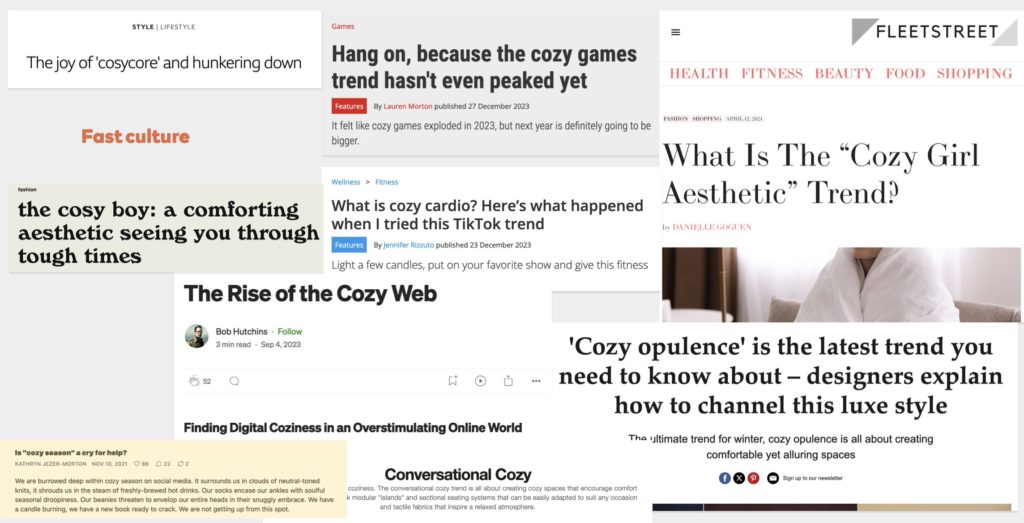
These headlines are all signals from the last year on various cosy subtrends that journos are writing about, but alongside these flash-in-a-pan-are-they-even-really-trends, the social data also shows us a move towards longevity and a cultural shift inward. Fast cosy culture can be used in your social, but is best as resposive content that captures a fleeting moment.
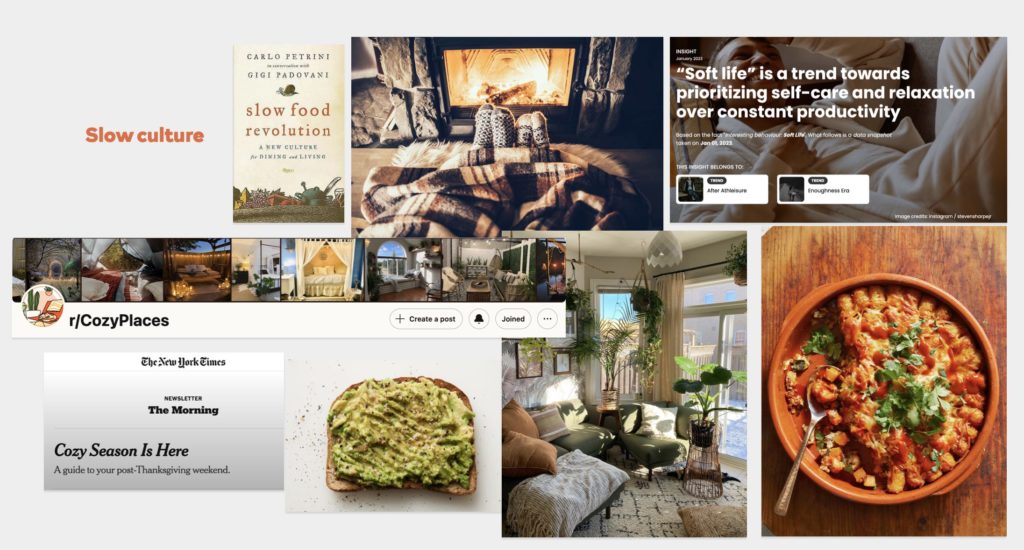
These slow culture signals are the cosy themes that have longevity, those rooted in tradition over fad. They tap into bigger human behaviours and desires and, as such, are better suited to a longer-form social strategy.
How is cosy playing out on social?
Who is talking about cosy things?
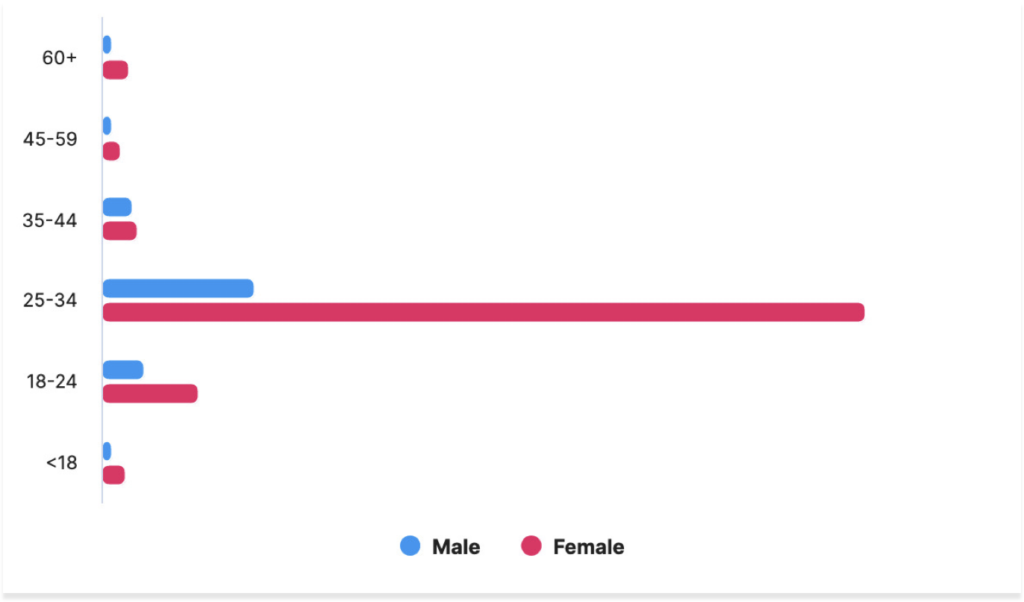
With a subject as big as this, I don’t usually pay too much attention to demographics, as they become more valuable as we cluster the audience.
However, I ran the audience to see if anything stood out immediately. This is what I found.
- The audience is very, very female.
- It’s the female audience who are responsible for the seasonal aspect of the trend, the male conversation is reasonably consistent throughout the year.
- The audience is truly global with a concentration in the US and the UK.
- The audience skews heavily younger millennial.
To begin my analysis, I grouped my data into eight broad themes that I saw repeatedly recurring. These were fashion, home, which encompasses all things house-based, including interior design and soft furnishings, the aesthetic, books/reading,TV and movies, gaming, music, and food.
How the Cosy Themes Manifest on Different Social Platforms. by Kim Townend
When dealing with multiple social networks, I look at something other than the cumulative volume of the themes as one platform can dominate and skew the data. As we saw before, Pinterest is that platform in this search. To better understand this, I’ve examined how cosy manifests on different social networks.
When writing social strategy, this kind of data is invaluable in helping me figure out which platforms are the most important to which communities and where the brand or business I’m working with should focus its efforts.
As you can see, Pinterest, TikTok, Twitter, and YouTube all have a very high percentage of home-based content, whereas Twitch and Reddit favour gaming more. This is immediately helpful to me in understanding where I should deep-dive on specific topics or where my brand should concentrate its ad spend.
Diving deeper I then look to understand two more things: which themes were more seasonal in nature/ which were more stable and secondly, how the overall engagement mapped against the themes.
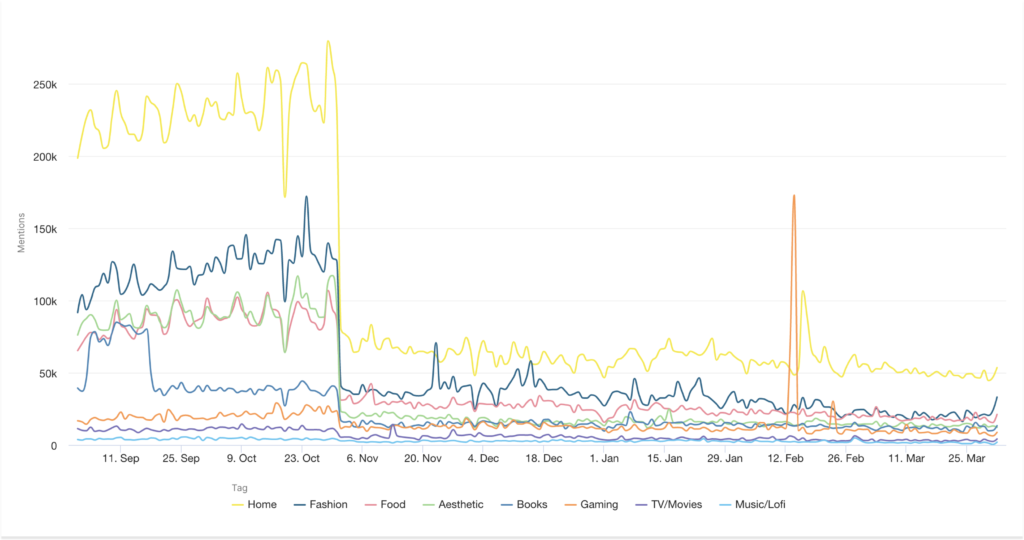
The graph above shows the timeline and the associated themes, you’ll see that ‘home’ has the biggest seasonal drop-off, fashion, aesthetic, and food have smaller drops, and gaming, TV & movies, and music, remain consistent throughout the year.
This suggests that while the more significant themes are seasonal, they continue growing each year and introducing smaller trends into their canon. The consistency around TV, music and gaming shows that these smaller trends are becoming sub-genres in their own right.
When i mapped this against engagement three things became clear:
- Level of engagement shows no correlation to volume of mentions. This has only really happened since the explosion of short-form video. When text/images were the default social content, engagement would usually follow a pretty similar line to mentions.
- Most of the huge spikes of engagement are driven by just one piece of content.
- Nine times out of ten that content is coming from either TikTok or YouTube
The Subgenres of Cosy
This blog post is already quite long, so I’m just going to do a top line look at the themes that were more consistent.
Books

- The only search that over-indexed in the UK spelling of cosy. A big UK audience but also many Anglophiles
- Twitter, TikTok and Reddit are key platforms for the cozy bookish, but early data shows threads is becoming a key contender in this space
- Cozy crime, cozy fantasy, and cozy mysteries are becoming full-blown sub-genres
- Cozy reading nooks crossover into the cozy home trend
Movies, TV, & Music

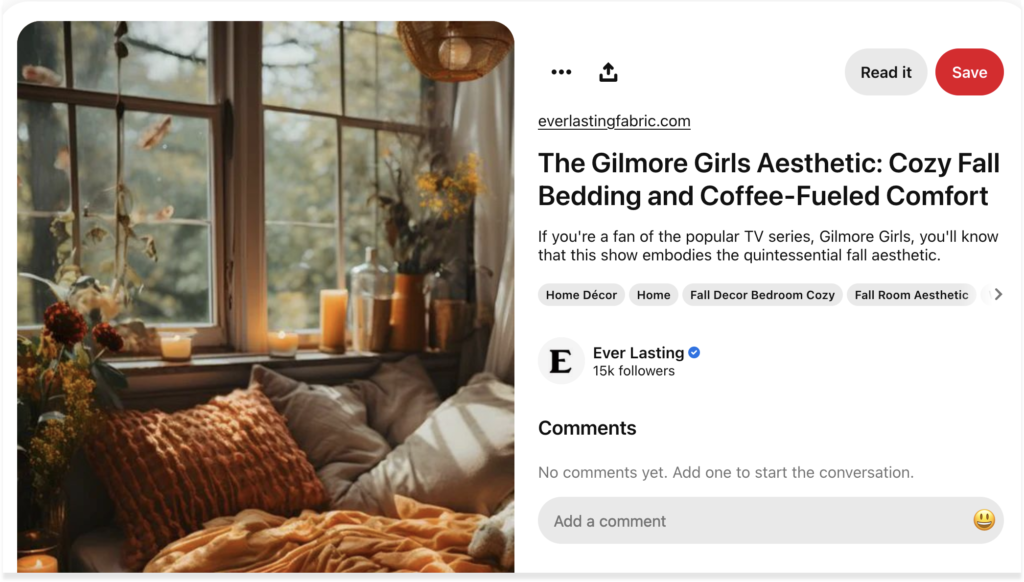
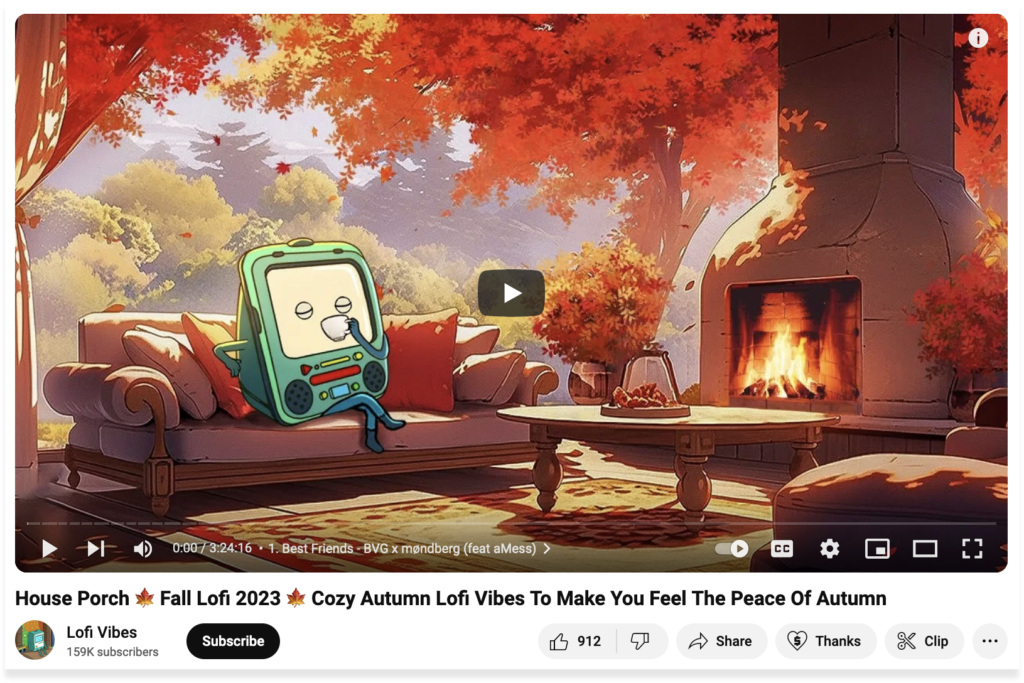
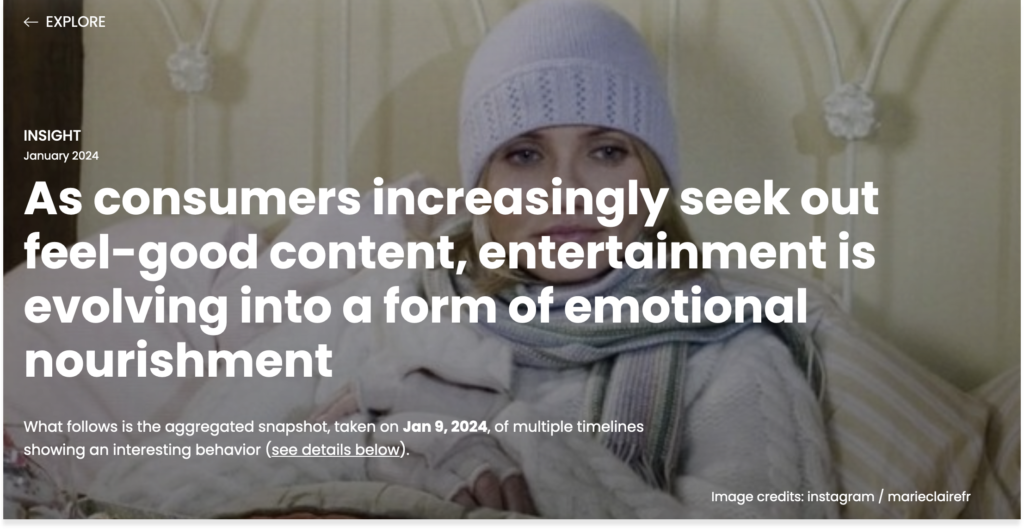
Although a smaller volume, cosy music is largely focused around seasonal lofi beats playlist videos, which are usually hours long, so the engagement time is phenomenal. Cosy beats was popularised by the lofi girl on YouTube, but has extended into hundreds of copycat channels. These channels are inherently seasonal with thousands of cosy fall/cosy winter/cosy spring and cosy summer specific playlists.
There’s a whole TV/Home cosy crossover around ‘The Gilmore Girls Aesthetic’, almost entirely driven by Pinterest. It’s super seasonal, but for every season, it has generated over 200k posts in the last year. Not bad for a TV show that aired 24 years ago! It ties back to the cosy love and ongoing trend of all things nostalgic.
Movie nights and in particular family movie nights are also part of this theme, people don’t talk about specific shows or movies, more the idea of getting cosy and watching something. The content itself is almost irrelevant.
Spotlight on Cosy Gaming
What is cosy gaming and why should you care?
Gaming is now a bigger industry than music, TV, and film combined. The UKIE projects it to be worth over 200 billion dollars globally by 2025.
People think of gaming as a male-dominated Call of Duty/Helldivers space. Although this is true tot a certain exten, there’s a growing gaming genre that is the opposite of this intense, action-fuelled melee. The concept of cosy gaming isn’t new; these types of games have been around for a long while.
Cosy gaming, or wholesome gaming, refers to video games that provide a relaxing, calming, and stress-free gaming experience, usually with simple gameplay mechanics, non-photo realistic visual styles, and a focus on activities like crafting, farming, exploring, or building. The trend gained popularity around the late 2000s and early 2010s with games like Minecraft and Stardew Valley, but it really kicked off again during the pandemic with Animal Crossing New Horizons. The vibe here is supremely low-stakes and peaceful.
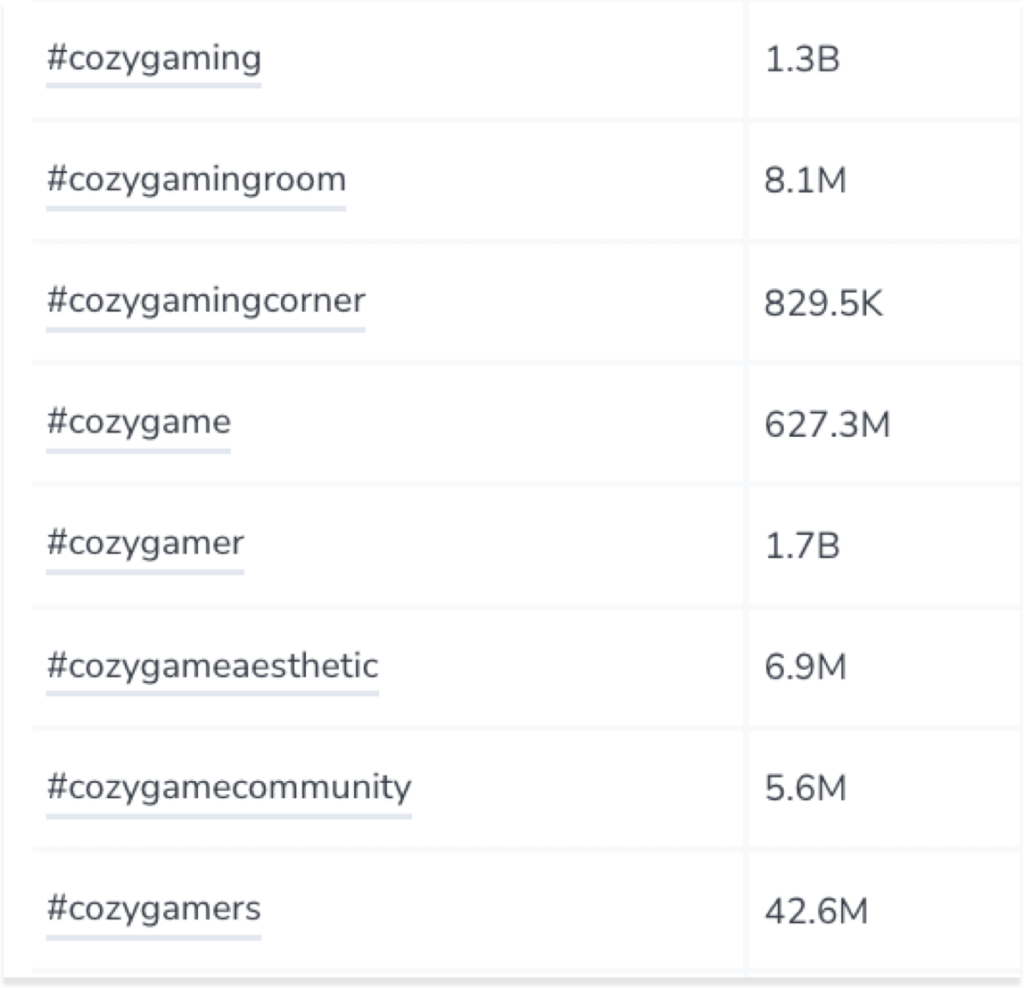
These are the hashtag views on TikTok around some of the bigger cosy gaming hashtags.
It’s quite large.
Below you’ll see the global search data around cosy gaming over the last five years. It’s definitely trending up.
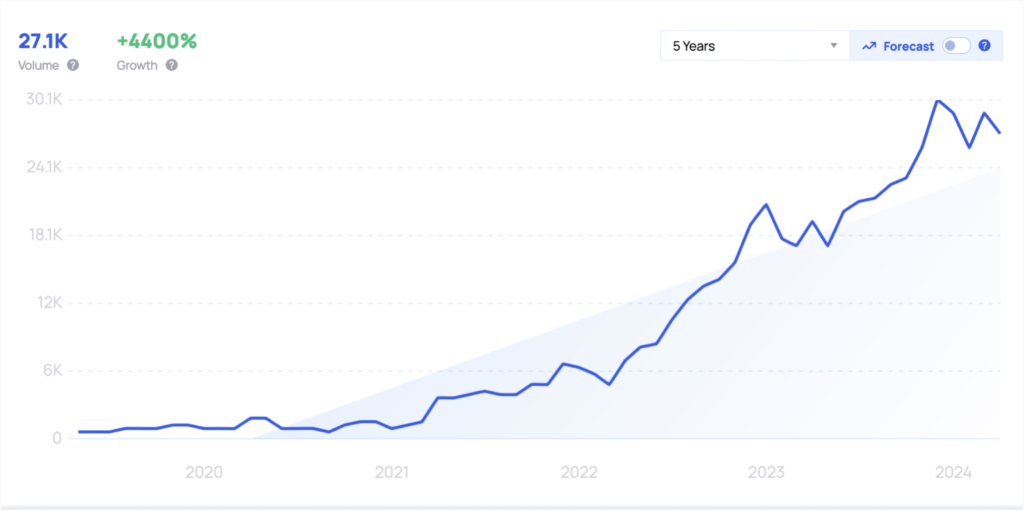
Key Findings
- Demographically, cozy gamers are much more likely to be female than male.
- Cosy gaming does not peak in Autumn/Fall but is instead remarkably consistent year round
- According to the data we can access, cosy gamers are most likely younger millennials.
- Cozy gamers are also into art, collecting, anime and cats
- As the market becomes more saturated gamers are becoming bored with
- formulaic games
- Nintendo Switch is the unofficial home of cozy gaming but since the release of the Steam Deck many gamers are considering switching due to the wider variety
- of games
- Reddit is just about the gaming whereas TikTok and Pinterest heavily crossover into the whole cozy lifestyle and aesthetic.

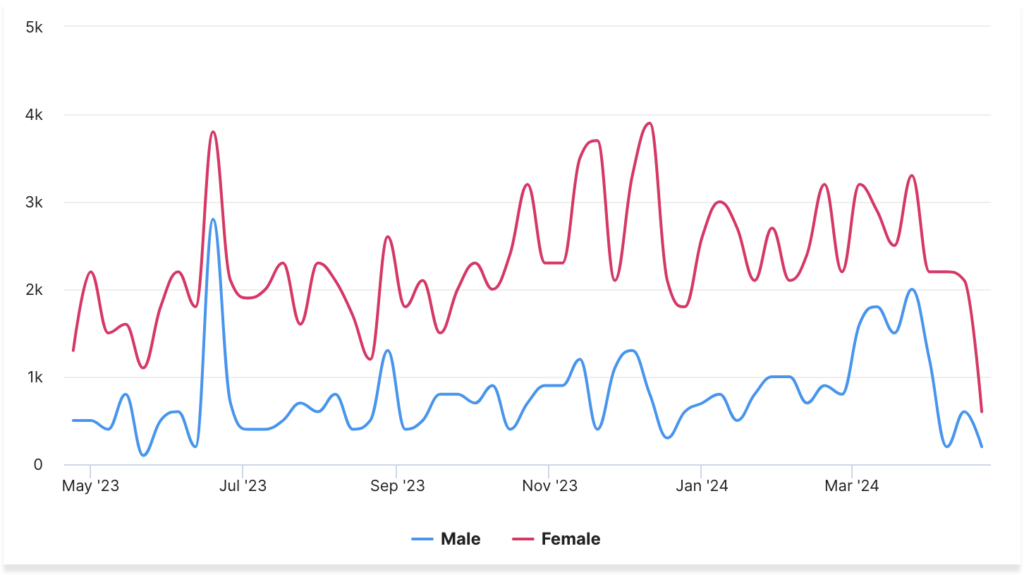
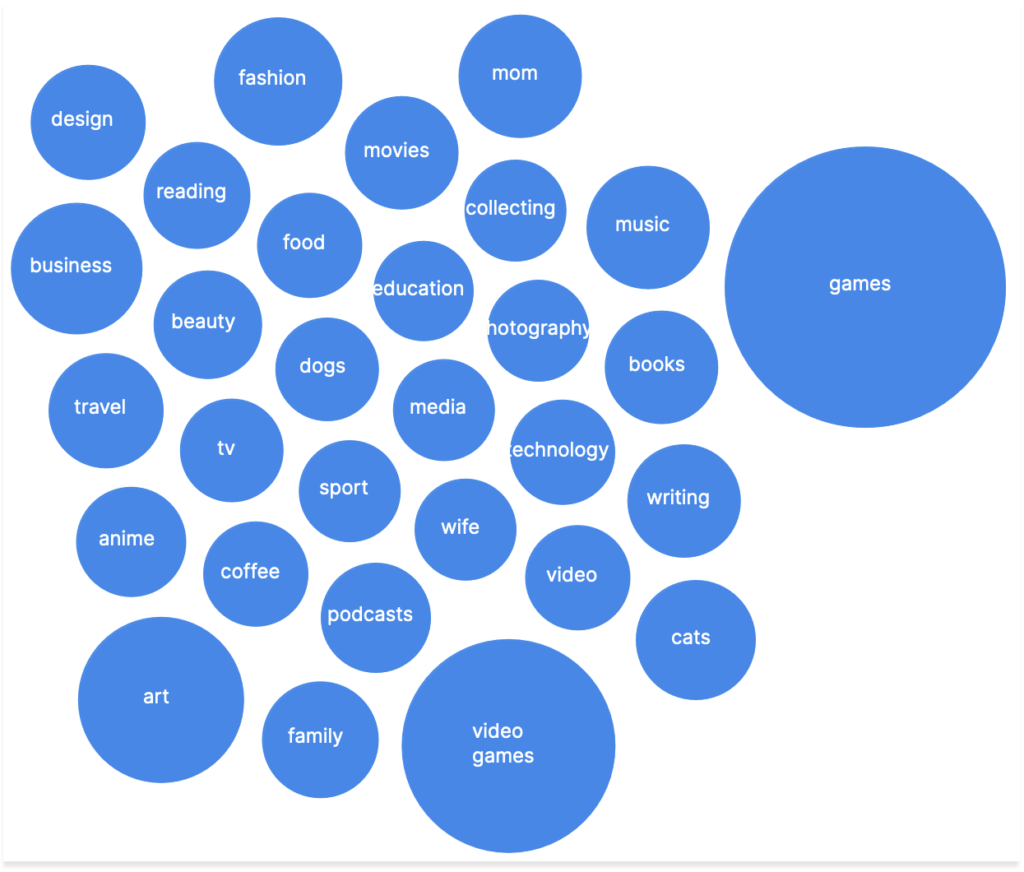
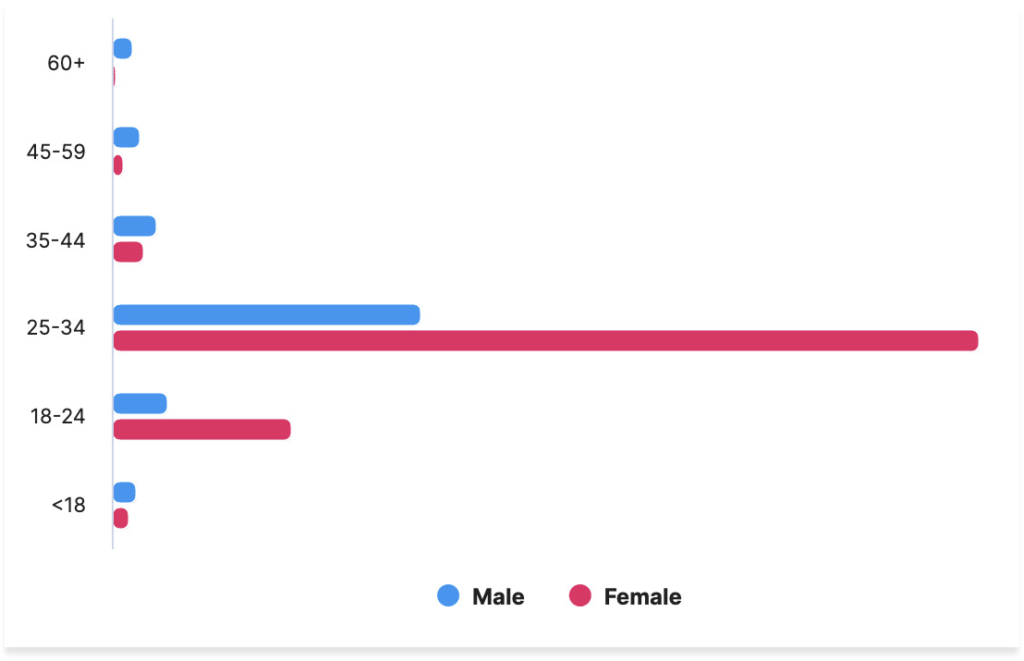
Cozy gaming is accessible to all!
The demographic data available to us will always have a platform skew.
I found this Reddit thread in r/CozyGamers last week talking about how old gamers on this sub were.
The ages ranged from teens to people in their mid-70s.
Cozy gaming is for non-traditional gamers.
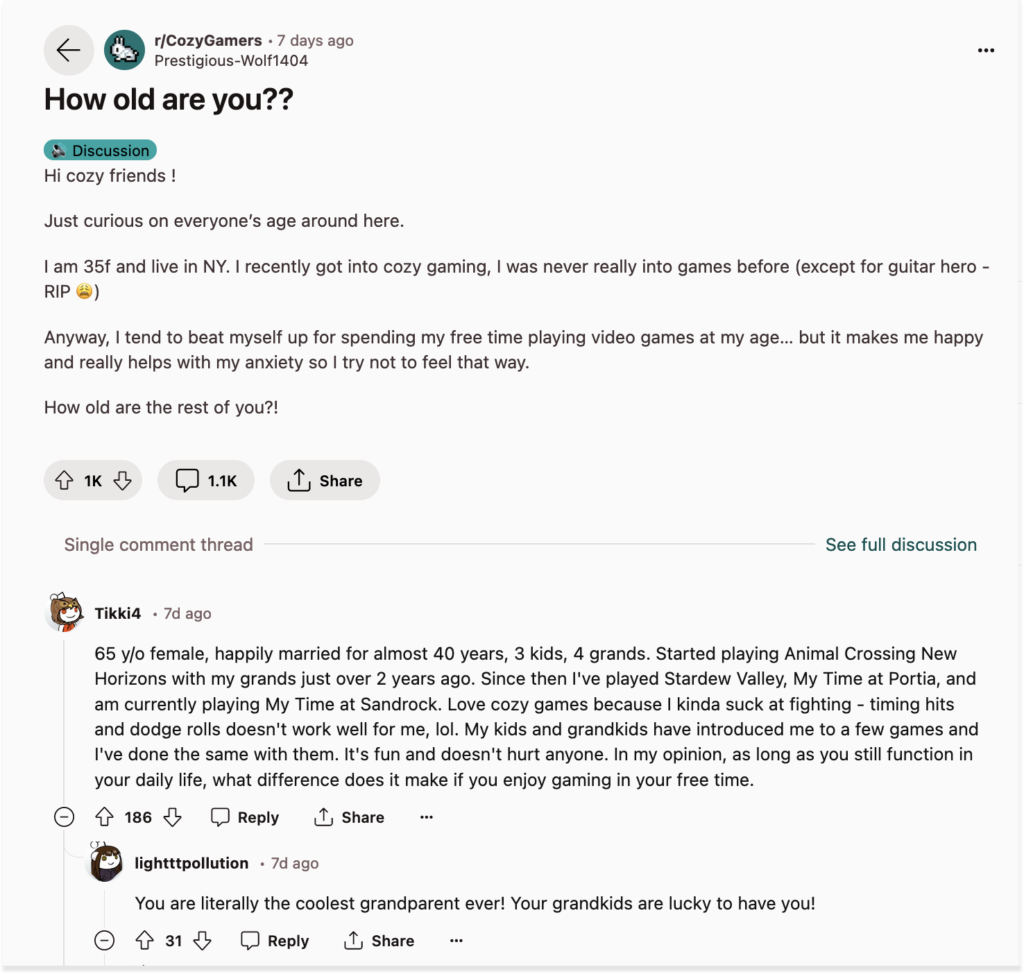
Final thoughts
In 2024 everything can be cosy.

This mass of connections shows the crossover from #cozy to other hashtags on TikTok over the last 60 days.
It crosses over with gaming, friends, autumn, interior design, ASMR, cottagecore, Minecraft, booktok, nature, Hello Kitty, loungewear, productivity, gardening, romance, moods, TV shows, photography, goblincore, cooking, and many more.
This is just one platform, 2 months worth of data, and outside of the traditional cosy season.
Cosy is here to stay and it’s happening year round.
If you’d like to learn more about anything I’ve shared here, or you have a project you’d like to collaborate on, please send me a message!
Events I have coming up
It’s been a busy start to the year, and over the next month I’m speaking at a few events /webinars.
Details are below.
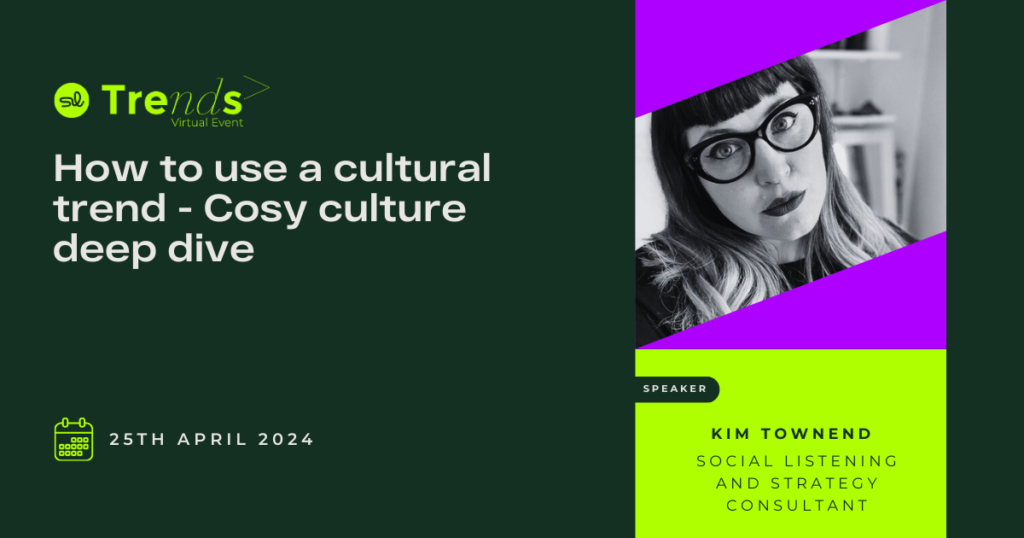
I’m speaking at the SilLab Trends Summit about all things cosy. Tickets and more info about the rest of the event can be found here: https://www.thesilab.com/trends-virtual-summit use code 10OFF for 10% the ticket price.

On May 3rd I’m in conversation at the State of Social Listening online, hosted by Piar. You can learn more about it and register to attend here.
There are a couple more coming up that I don’t have all the details of yet.

Finally, I’ll be talking all things functional mushrooms with co-collaborator Jess Jorgensen at a webinar for the ICG on May 30th. Registration link to follow!
TikTok Social Listening 101.

TikTok 101
Everyone has heard of TikTok. In 2023, it had 1.5 billion monthly active users, and by the end of 2024, it’s expected to reach two billion.
TikTok started life as Bytedance in 2017, a short form video sharing platform focused on dancing and lip-syncing videos. Fast forward to 2024, and TikTok is a social media app where users share (mostly) short-form video content (although we’re starting to see a shift towards longer-form content happening this year). Posts on the platforms are TikToks and they can be stitched together, or users can duet with each other’s TikToks.
Like Twitter, TikTok runs on hashtags. Most of the popular TikTok trends you’ve heard of started out as a lowly hashtag before becoming a part of pop culture history. For example, the I’m the Main Character trend emerged on TikTok in 2020 before becoming a part of accepted internet speak.
It’s not all video; the audio is just as important. Users can add songs or other audio clips to their videos. The TikTok Creative Centre makes choosing sounds (and hashtags) super easy, as you can see what’s currently trending on the platform for free.
TikTok uses an algorithm that generates user-specific recommendations on the #FYP (for you page). Top tip for you; getting on a user’s FYP is a surefire way to reach the widest and best audience.
In 2023, TikTok launched ‘TikTok Shop’ and became a bona fide social shopping site. Users can either sell their own products or become affiliates for brands. It’s estimated that TikTok shop generated $20B in revenue in 2023.
And, as if that wasn’t enough, TikTok is edging towards search engine territory. You may already be aware that Gen Z is using social media for search, but did you know that TikTok is already outperforming Google in key areas, including fashion? TikTok is putting search front and centre of the latest update. So on top of everything else, it’s now one of the most valuable platforms for SEO keyword identification too.
Why should you care about social listening on TikTok?
TikTok has been the fastest-growing social network for the last few years. It is the original home of short-form vertical video, which Meta was ‘inspired by’ when it created Reels for Instagram, and now even LinkedIn is looking to pivot towards.
TikTok runs on trends, and the average engagement rate is much higher than that of the other social networks. This means that TikTok is pretty much powering the social internet. Trends you see on TikTok will eventually filter through to other social media channels.
Understanding what’s happening on TikTok can not only help you and your business get involved in the latest relevant trending topics but also help you over time by identifying longer-term cultural shifts, allowing you to create future-facing content strategies.
How should you start social listening on TikTok?
In this section, I’ll explain what you need to know to start social listening on TikTok
As with all social listening projects, you first need to get clear about the audience you care about and what you want to learn about them.
Identify the audience you want to listen to on TikTok
Knowing who we want to listen to on TikTok is step one. Ideally, you want to consider these audiences based on their interests rather than demographic data. Communities on TikTok unite around hashtags that end in ‘tok’. There’s a Tok for everything, so the more specific you are, the better the results.
Say you’re launching a new software platform to connect smaller brands with bigger opportunities; you might be interested in better understanding Gen Z entrepreneurs.
A publishing company might want to understand the super-sized reading community on #booktok.
Once you know who you want to listen to, you can do some desk research on the things that this audience might be interested in on TikTok. We’ll talk more about this in the ‘what should you be listening to on TikTok’ section.
Set your goals
Before we get into the details of how you’ll use TikTok for social listening, we must figure out what you want from your TikTok listening.
Are you looking to identify trends relevant to your audience so you can create better opportunities? Or are you just looking to understand more about who your audience is and the type of content that engages them? Do you want to set up a TikTok shop, or do you want to identify influencers who will resonate with your target audience?
Each goal will shape how you set up your social listening on TikTok, as you’ll use them to guide which keywords or hashtags you want to focus on.
What to look for when choosing a TikTok social listening tool
Social listening on TikTok will be difficult without a social listening tool. A social listening tool is a platform that allows you to track and analyse TikTok data. Although all the big social listening tools offer a TikTok component, some newer tools have been built to listen only to TikTok. These tend to be a bit more advanced regarding the insights they provide.
When choosing a social listening tool, you should consider these three key things.
1. What are you going to use the tool for? You should have covered this earlier when you were thinking about business goals. Prioritising influencer identification over trending topics will guide your choice of social listening tool
2. Your budget. Social listening tools come in all shapes and sizes; some are aimed at small businesses, and some offer enterprise solutions. Understanding how much you want to spend will be a defining factor in the tools you choose
3. Will you be listening to TikTok in isolation, or will this be a part of a wider social listening project?
TikTok Social Listening Tools
In this section, we’ll share some of the social listening tools we’ve previously used for TikTok projects. To make things easier, they’re grouped by budget.
Mid Range:
Exolyt. Exolyt is explicitly designed for TikTok and is a great quality tool, with accounts starting at a very reasonable price. With Exolyt, you can track hashtags, compare SOV, understand sentiment, and much more. There are also options to understand trending hashtags, sounds, and influencers on the platform. It’s a great TikTok-specific solution.
YouScan. YouScan is also an enterprise platform but has an affordable small business option that is really impressive. YouScan is another social listening tool that allows you to monitor multiple platforms, including TikTok.
The TikTok insights are fantastic and feature some world-class visual/logo analysis alongside influencer analysis, audience interests, and the ability to create dashboards and tag posts so you can analyse your data more thoroughly.
Enterprise.
ViralMoment. ViralMoment is a TikTok-specific enterprise solution. It allows you to do super deep-level analysis of almost anything that you want on TikTok. You can track audio and visuals in TikTok, alongside learning what’s trending in your industry, benchmarking yourself against competitors and more.
What should you be listening to on TikTok?
Social listening on TikTok is a bit different from social listening on other platforms, and what you can do depends on the tool that you’re using. Here are some key areas you might want to consider.
- Hashtag tracking is entry-level TikTok listening. You’ll identify hashtags relevant to the audience you’ve decided on (way back in the “identify your audience” section) via desk research and then begin tracking them in your tool of choice. It’s helpful to look at the other hashtags your audience uses alongside what you’re tracking. This gives you a better understanding of your audience’s interests.
- On-screen captions—Certain TikTok listening tools allow you to track the on-screen captions that are added to TikTok.
- Main caption: Most listening tools will allow you to track what the post’s author has written; this is as useful as hashtag tracking for identifying key themes across time.
- Trending topics – While we don’t advocate for brands to jump on every trending topic that appears, there’s no denying that it can be a valuable way to get in front of a wider audience if it’s relevant to your brand.
- Trending sounds – Same as trending topics. Although you might not be using them yourself, understanding what your audience is seeing and hearing helps you understand their mindset and create better content to engage with them
- Comments—Not as many tools will pick up TikTok comments, but these can be a goldmine of useful information as people respond to the hashtags. They really help contextualise your search.
- Audience Insights—Understanding your audience’s demographic makeup and interests is really useful for a myriad of reasons!
- Influencer Identification—Getting to know the influencers in your interest area is key to deciding who to work with. Most tools include this.
Is TikTok Even Right For You?
A couple of years ago, TikTok was primarily used by Gen Z and Alpha, but these days, that’s changing. TikTok is notoriously cagey about sharing too much user data. Still, according to App Ape, the current TikTok user demographic split in the US shows us that almost 40% of TikTok users are over the age of 30. This means it’s more than likely that you will find an audience for your business on TikTok.
However, it’s still best to do some desk research and learn how many views your hashtags/keywords of interest are getting. It might not currently be the best way to get your content in front of the C-Suite, but TikTok is always widening its user base.

In Conclusion
TikTok is huge and continues to grow, and it’s no longer ‘just’ a place to connect with Gen Z. If you’re not listening there you’re probably missing out on something really good.
TikTok is also a huge revenue generator, with TikTok Shop levelling the playing field between brands, influencers, and consumers. This has opened up tonnes of opportunities and made it even more critical to track what’s happening on the channel.
Social listening on TikTok is pretty complex as there are so many different areas to analyse. You’ll need a TikTok listening tool if you want to do it properly. Hiring a pro is the easiest way to get the insights you require and strategic guidance on applying them, taking your social content to the next level.
Basically, TikTok is where internet trends begin. Listening can help you identify the best fit for your business, leading to more eyeballs on your content and all sorts of other benefits.
As always, get in touch if you want to find out more about how I can help you with anything TikTok related!
What you’re getting when you hire me.
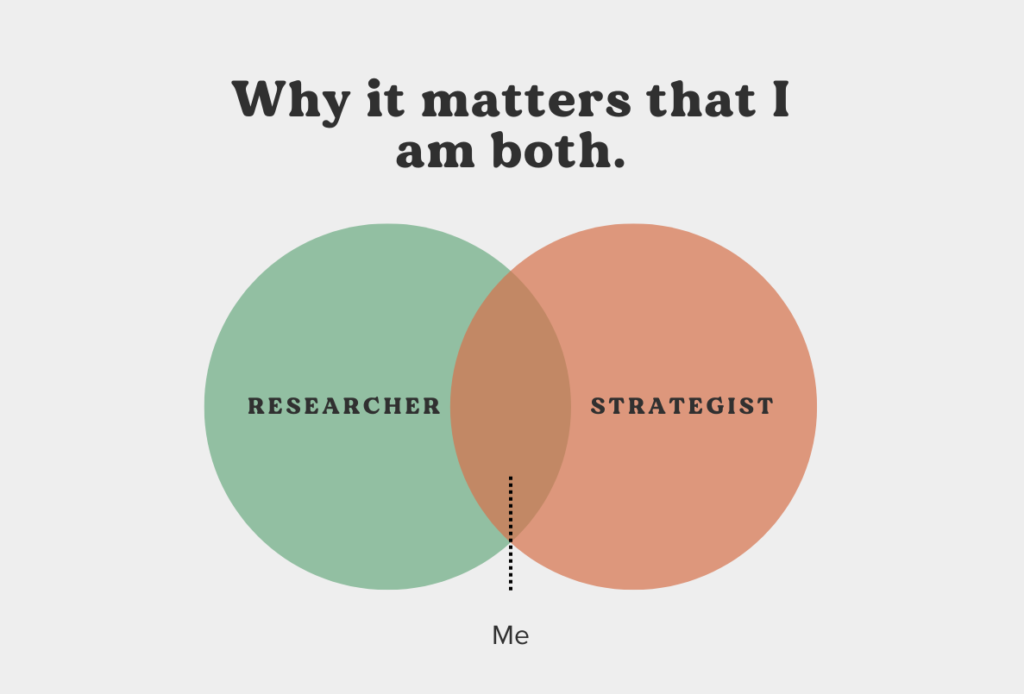
I’ve worked in social media since 2006 and have been a social/digital strategist for the majority of my career.
Being a social strategist is very similar to being most other kinds of strategist, besides the requirement to stay across the updates, algorithms and ever-changing requirements of multiple social networks.
”You still have the same work to do in understanding client goals and the market’s general state and identifying the insights you can leverage to give you the best chance of success. Or, as Mark Pollard puts it,“Strategy is an informed opinion on how to win.”You still have the same work to do in understanding client goals and the market’s general state and identifying the insights you can leverage to give you the best chance of success. Or, as Mark Pollard puts it, “Strategy is an informed opinion on how to win.”
So, how am I different, and why should you care?
I’ve used social listening in some form for almost the entire span of my career. I believe that the better we understand our audience, the better the strategy we can create, the better the content/product/insights we can produce, ultimately leading to the best results we can achieve.
Usually, social listening pros and social strategists are two different professions. One will brief the other on the sort of insights that they’re looking for; the social listening person will generate the insights based on what they think the strategist wants and relay them back to the strategist, who will use them to create their strategy. This increases the chance of miscommunication and often means the most valuable insights stay hidden.
On top of this, social listening is usually only available to people who can afford advertising or creative agencies, as alongside the cost of the software and data, you’re also looking at the cost of two people’s time.
With me, you’re getting the whole department in one person.
As an experienced strategist, I’ll shape the search to deliver precisely what we need and pivot if the search shows us a different direction. But the real magic happens in that I can take the insights I’ve generated and create a strategy that takes all of them and the nuances that don’t make it into the deck into account. There’s no disconnect or miscommunication between the insights and strategy teams when they are the same person!
So you, the end client, are getting an incredibly well-researched piece of work that gives you tangible goals and KPIs to work to, that take into account not only all the things we’ve learned about our category and audience through social listening but also how many posts we need to put out, in what format, and how TikTok differs from Instagram, and if we need to be on LinkedIn as well.
In many situations, I’ll even be able to recommend a social media manager to take care of the day-to-day posting for you. I can work with you on an ongoing basis to ensure that you’re taking advantage of any platform shifts and updates, review our KPIs, and evolve our strategy if our learnings show that this is required.
So, if you want agency-quality work without the agency price tag, message me and let’s talk.